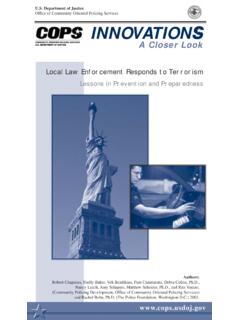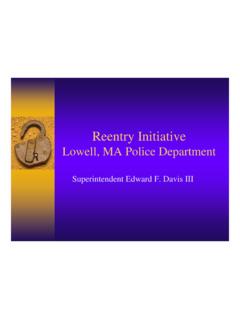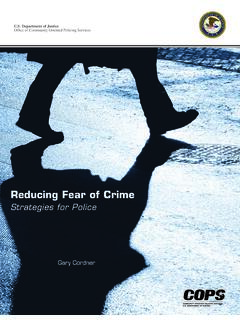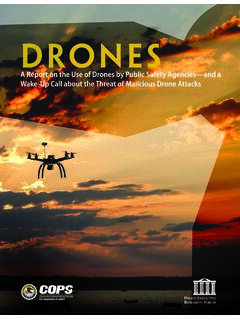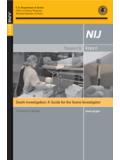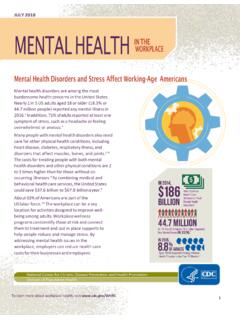Transcription of Crime Prevention Research Review No. 3: Does …
1 Crime Prevention Research ReviewNo. 3 Does Neighborhood Watch Reduce Crime ?Katy Holloway University of South WalesTrevor Bennett University of South WalesDavid P. Farrington University of CambridgeSuggested citation: Holloway, Katy, Trevor Bennett, and David P. Farrington. 2013. Does Neighborhood Watch Reduce Crime ? No. 3 of Crime Prevention Research Review . Washington, DC: department of Justice, Office of Community Oriented Policing Services. The opinions contained herein are those of the author(s) and do not necessarily represent the official position or policies of the department of Justice.
2 References to specific agencies, companies, products, or services should not be considered an endorsement by the author(s) or the department of Justice. Rather, the references are illustrations to supplement discussion of the issues. The Internet references cited in this publication were valid as of the date of this publication. Given that URLs and websites are in constant flux, neither the author(s) nor the Office of Community Oriented Policing Services can vouch for their current validity. The Campbell Collaboration Crime and Justice Group ( ) is an international network of researchers that prepares, updates, and rapidly disseminates systematic reviews of high-quality Research conducted worldwide on effective methods to reduce Crime and delinquency and improve the quality of published 2008 Revised 2013 ISBN: 978-1-932582-73-4 Cover photo: Doug RauContentsAcknowledgments.
3 1 Introduction ..3 Previous Reviews of the Literature ..5 What Is Neighborhood Watch? ..7 How Is Neighborhood Watch Supposed to Work? ..11 Systematic Review of Neighborhood Watch ..15 Eligibility Criteria ..16 Search Methodology ..17 Selected Publications ..17 Summary of Results ..18 Meta-Analysis ..21 Individual Effect Sizes ..22 Combined Effect Size ..22 Moderator Analyses ..23 Conclusions ..27 Research Implications ..28 Implications for Policy ..29 Studies Included in the Review ..33 References ..371 AcknowledgmentsThe authors acknowledge the Campbell Collaboration Crime and Justice Group for its support in conducting the systematic Review on which this paper is based.
4 In particular, we thank David B. Wilson and David Weisburd for their advice and assistance at earlier stages in the Research . We also acknowledge the contributions of the anonymous reviewers for their helpful comments on draft versions of the Campbell Collaboration report. Thanks also are due to Tracy Pitman for her Research note regarding the Crime Prevention Research Review SeriesThe Research included in this Crime Prevention Research Review is limited to studies that use experimental or quasi-experimental designs and meet the criteria for rigor as laid out in The Campbell Collaboration Crime and Justice Group Review criteria (see ).
5 It is important to note that other pieces of evidence regarding the effectiveness of various strategies were excluded from this Research . The popular series of Problem-Oriented Guides for Police (POP Guides) published by the Office of Community Oriented Policing Services (COPS Office) differs significantly from this Review because the standards for inclusion of evidence are less tied to the use of experimental designs and thus include a wider range of evidence. IntroductionConsidering such large investments of resources and community involvement, it is important to ask whether neighborhood watch is effective in reducing watch grew out of a movement in the United States that promoted greater involvement of citizens in the Prevention of Crime (Titus 1984).
6 Variations include block watch, apartment watch, home watch, citizen alert, and community watch. The main method by which neighborhood watch is supposed to help reduce Crime is when residents look for and report suspicious incidents to the police and thereby perhaps deter potential offenders from committing a Crime (Bennett 1990). One of the first evaluations of neighborhood watch programs in the United States was of the seattle (Washington) Community Crime Prevention Project launched in 1973 (Cirel et al. 1977). One of the first evaluations of neighborhood watch programs1 in the United Kingdom was of the Home Watch program implemented in 1982 in Cheshire (Anderton 1985).
7 Both evaluations identified a greater reduction in burglary in areas where neighborhood watch programs had been introduced, than in comparison the 1980s, the number of neighborhood watch programs in the UK has expanded considerably. The report of the 2000 British Crime Survey estimated that more than a quarter (27 percent) of all households (approximately six million households) in England and Wales were members of a neighborhood watch program (Sims 2001). This amounted to more than 155,000 active programs. A similar expansion has occurred in the The report of The 2000 National Crime Prevention Survey (National Crime Prevention Council 2001) estimated that 41 percent of the American population lived in communities covered by neighborhood watch.
8 The report concluded, This makes neighborhood watch the largest single organized Crime - Prevention activity in the nation (39). Considering such large investments of resources and community involvement, it is important to ask whether neighborhood watch is effective in reducing Crime . To investigate this, we reviewed all available studies evaluating the effectiveness of neghborhood watch programs in reducing Crime . In this publication we summarize the findings of this Review and discuss policy implications. 1 In this publication, neighborhood watch is referred to as a program; however, in the UK and other countries they are commonly referred to as schemes.
9 Previous Reviews of the LiteratureNearly all studies found that neighborhood watch areas were associated with lower levels of Reviews of the LiteratureThere have been several previous literature reviews of the effectiveness of neighborhood watch programs. One of the earliest conducted in the was by Titus (1984) who summarized the results of nearly 40 community Crime - Prevention programs. Most of these included elements of neighborhood watch. The majority of studies were conducted by police departments or included data from police departments.
10 Nearly all studies found that neighborhood watch areas were associated with lower levels of Crime ; however, most of the evaluations were described as having weak Research methods. Another literature Review looked mainly at community watch programs in the UK (Husain 1990). The study reviewed the results of nine existing evaluations and conducted an original analysis of community watch in six additional locations using police-recorded Crime data. The Review of existing evaluations concluded that there was little evidence that neighborhood watch prevented Crime .
